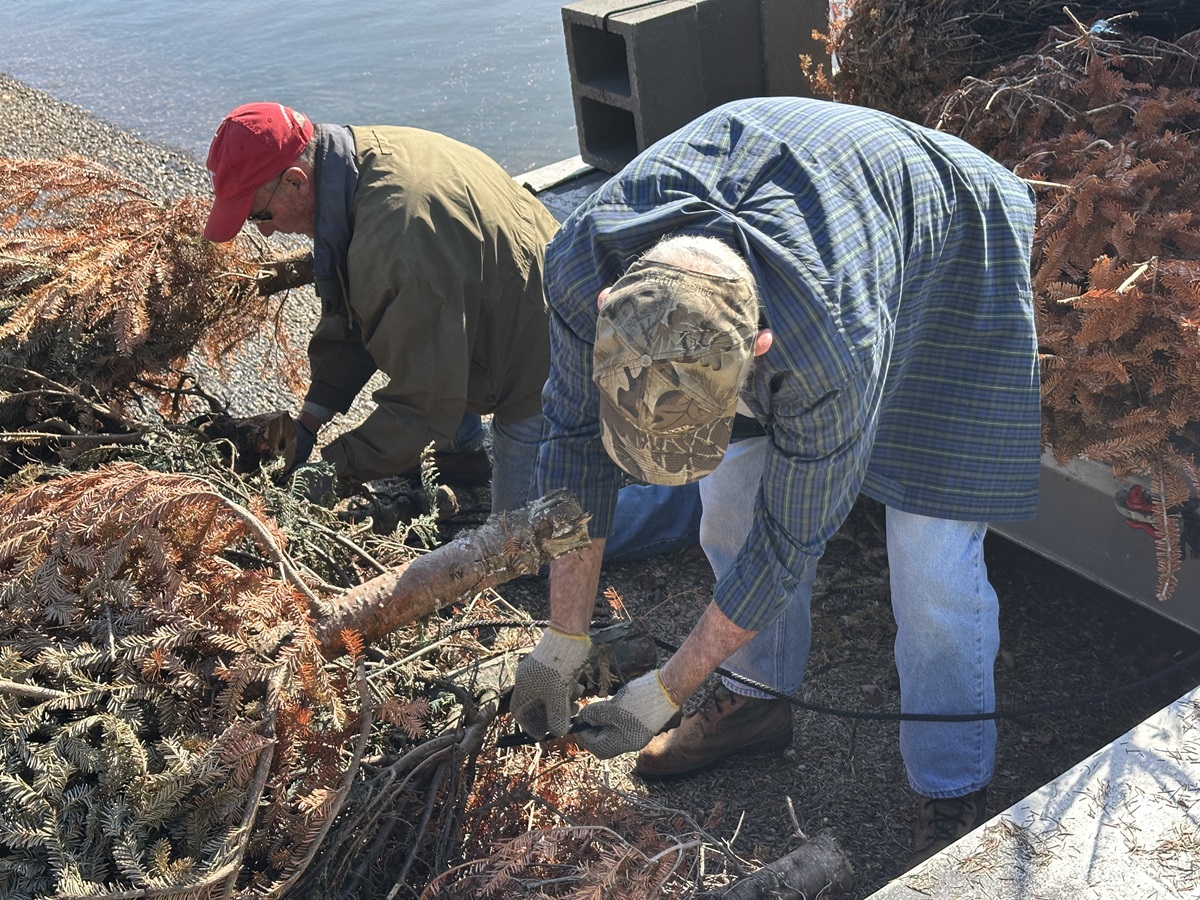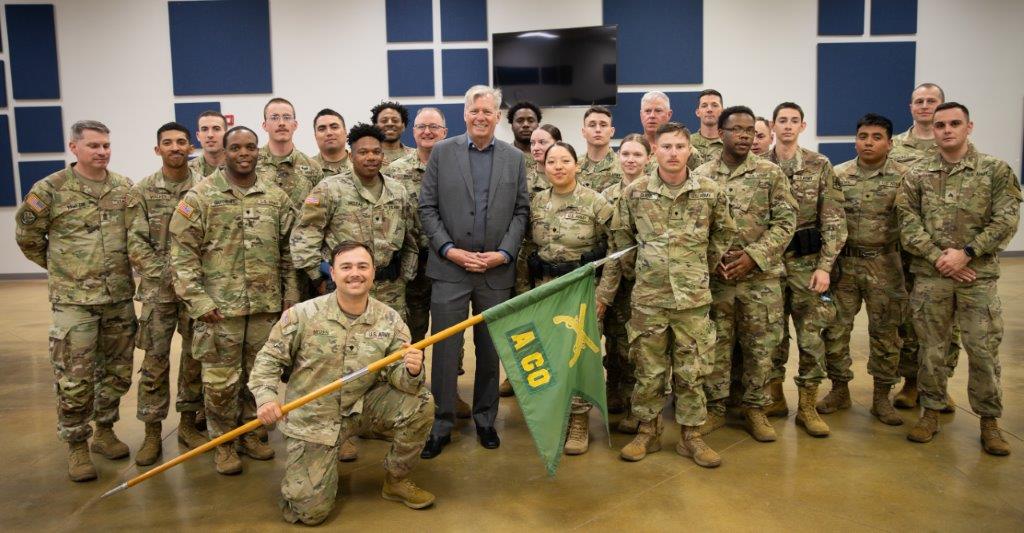USS Alabama Living History Crew brings World War II engagements to life in Mobile Bay

Smoke trails from an attack plane as gunners fire at it as part of the USS Alabama Living History Crew drill. (Robert DeWitt / Alabama NewsCenter)
Jim Grupczynski wouldn’t want any other job on the ship.
“When you look at a battleship, what do you see – guns,” said Grupczynski, pointing back to the USS Alabama’s aft turret of 16-inch guns. Grupczynski plays the part of the gunner’s mate first class for the Alabama’s Living History Crew.
“He pretty much runs the gun,” Grupczynski said. “I’m the go-to guy on the quad 40mm on top of the turret and the three 20mm guns in this battery over here.”
The Alabama’s guns haven’t fired a shot in anger for more than seven decades. But in recent years, a group of volunteers dedicated to preserving the ship’s history have reawakened two of its anti-aircraft batteries for realistic, crowd-pleasing demonstrations.
“We try to pay tribute to the veterans of World War II,” said Chip Dobson, the Living History Crew’s executive officer. “We try to pay tribute to the veterans of this ship.”
Reliving history aboard the USS Alabama from Alabama NewsCenter on Vimeo.
Commissioned in 1942 and nicknamed the “Lucky A,” the Alabama served mostly in the Pacific Theater during World War II. In 1965, it was saved from the scrapyard and towed to Mobile where it now sits in its berth at Battleship Park and serves as a museum ship. Visitors can wander around the ship and get a sense of what life was like on board during World War II.
During bi-monthly drills, the Living History Crew serves as re-enactors to make the experience more real for visitors. About 40-50 Living History Crew members came aboard on a recent Friday night to become fully immersed in the experience. They ate and slept onboard and then on Saturday performed crew activities and talked to visitors about life onboard the ship.
Those activities can be as mundane as swabbing the deck and granting permission to come aboard. But the day’s centerpiece is a staged attack by vintage aircraft.
“The air attack is about as real as it gets,” Dobson said.
A bugle blared over the ship’s intercom and a steely voice says, “General quarters. All hands man your battle station.” The gunners slipped into three restored 20mm anti-aircraft guns on the starboard side and manned the 40mm anti-aircraft guns on top of turret no. 3. A crew member dressed as a Marine attached a Browning .30 caliber machinegun to a mount next to the 20mms.
After a few minutes, an officer with a pair of binoculars standing behind the 20mm battery pointed over the ship’s stern.
“There they are, 7 o’clock,” he said.
Grupczynski began communicating with the gunners as the planes flew past and turned to make a torpedo run. The gunners tracked them and then began firing as the planes approached, making a torpedo bomber run just above the waters of Mobile Bay. The staccato rattle of the 20mms came in short bursts while the 40mm rumbled with a slower rhythm.
Just in front of the ship, the planes turned and climbed and the gunners swung with them like a hunter tracking a flaring duck. Behind a rope to the rear of the 20mm battery, applause broke out from spectators.
On the next run, the gunners engaged again and a smoke canister went off near them. The damage control crewmen came with the ship’s fire-fighting equipment and doused the faux flames. As the attack continued, officers and sailors fell to the deck. Medical corpsmen ran in with a Stokes Basket and carried off the “wounded.”
Dobson said the crew likes to involve spectators, particularly youngsters, when possible. During this drill, a young girl in a T-shirt and shorts, looking anything but wounded, got carted away.
After several runs, the planes paraded past to cheers from the gun crew and crowd.
The guns are restored World War II weapons but, of course, don’t fire live rounds or even blanks. They have been modified to accept a propane/oxygen mixture that a device like a spark plug ignites in the firing chamber. They make noise but there is no recoil or shell casings spewing out of the breech.
The re-enactment tries to be as accurate with the aircraft as possible and uses vintage Japanese planes when possible. This time, a vintage Russian YAK and a small jet stand in for Japanese Zeros and Bettys.
“I thought it was awesome, great job,” said Travis Gilstrap of Crossville, Tenn. His wife, Jessica, daughter, Elizabeth, and son, Devon, nodded in agreement. The Gilstraps had visited Orange Beach and decided to stop by on their way home, unaware they would get a living history bonus.
“It was a great stop,” Jessica Gilstrap said.
Both kids enjoyed the air attack.
“I liked it when the planes were coming down and going over the ship,” Elizabeth said.
“I liked the guns,” Devon said. “I liked, really, everything,”
Crew members enjoy playing their parts.
“It’s a lot of fun,” said Lucian Maddox of Gautier, Miss., who plays a damage control crew member. “The crowd generally likes it. That’s what it’s all about, making sure they see something they wouldn’t normally see.”
Maddox spent 10 years in the Navy as an electrician’s mate and he still works for the Navy.
“I have to admit, it’s a lot of fun getting back in uniform,” he said.
Galen Wagner of Mobile served as a sergeant in the Marine Corps and plays a Marine sergeant in the Living History Crew. The Alabama carried a contingent of about 200 Marines.
“People come here and they can walk around the ship but it’s hard for them to imagine there were 2,500 guys on this ship,” Wagner said. “It’s good to be able to educate them about the human element.”
Additional Living History Crew drills are scheduled for Aug. 19-20, Oct. 7-8 and Dec. 2-3. For information about the Living History Crew, visit ussalabamalivinghistorycrew.com.
























